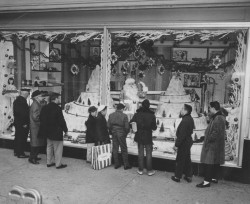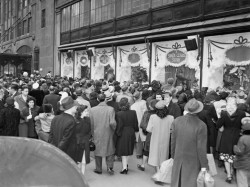Monthly Archives: December 2016
Seattle is cracking down on greedy landlords:
After many months of process, the Seattle City Council voted 8-0 to restrict move-in fees imposed on tenants, and give renters more options in how they choose to pay these and other costs associated with moving.
The legislation is part of what Councilmember Kshama Sawant has called a “Tenants Bill of Rights” — a methodical unveiling of renter-friendly laws that, when taken together, can be viewed as a complete package.
Sawant introduced the legislation last summer with the Washington Community Action Network, a local advocacy organization. It takes several unprecedented steps. For one, it restricts the security deposit and non-refundable fees — often labeled as cleaning fees — to one month’s rent. Second, it will allow tenants to pay the security deposit as well as last month’s rent in installments.
What’s interesting to me about this battery of regulations is how it runs almost the opposite of the problems I’ve seen with dubious landlords back in Colosse. Back there, it was never really an issue about what they would do to you when you moved in, but rather what they would do once they had you. After you’d moved in.
A long time ago I was chatting with a newly-wed friend from Canada who was apartment hunting. He was frustrated because they couldn’t find a good place. Worse yet, the places he did find wanted a six month or year-long lease. I wasn’t quite sure the issue when he said that, though. Was he looking for something longer? No, he was aghast at the notion of signing a lease. Only unscrupulous landlords in Toronto did things like that. If their apartment was good, then why would they want to lock you in?
This was the opposite of my view, to a degree. We always wanted a lease because a lease locked in the rent. As long as you were on that lease, they couldn’t raise it on you. And after that, it was often open season. And that, rather than the things Seattle is seeking to regulate, was always the issue. They would have low introductory rents, often with the first month free or 30% off the first three months and whatnot. The goal to get you to move your stuff in. Then, once you’d moved your stuff in, they would often had some formula explaining how much they could gouge you for to line their pocketbooks without tipping you towards moving.
Rent going up after the end of the lease was norm, even if rents for new tenants was holding steady and introductory offers were getting better. So the very things that Seattle seeks to combat, gouging them at the move-in, was really a non-starter. If I’d wanted to regulate the Colosse market, it would combat the opposite thing as Seattle.
Which makes sense, to a degree, because of the different markets. The Seattle rental market is pretty tight and therefore being able to find a place at all can be a challenge. That, in turn, gives landlords an awful lot of leverage. Meanwhile, in Colosse, expansion occurs in all directions and there is not shortage of places. So to get you to notice them, they need to have big signs saying “First month free!” or something of the like. The only time they do have leverage over you is once you’re moving there. So that’s when they turn the screws to subsidize the people that just moved in.
It began with Wolf and Dessauer. In the years before shopping malls and chain retail stores, Wolf and Dessauer was where Fort Wayne shopped. A purely local department store, it made its name as a place that was not just for shopping, but twas a social experience, with high levels of customer service, lounging rooms for tired shoppers, and access to telephones for people who who did not yet have one at home.
And Christmas was (so I hear; it was before my time) a magical time at W&D. They were famous for their magic windows, which some say were the equal of Macy’s.
In 1937 W&D hung a 25 foot wreath containing a reported 40,000 lights from the side of the building. Then in 1940 they constructed a 51 yard long display of Santa and his reindeer . Made of wood and containing (depending on which of the many unverified sources one believes) between 24,000 and 40,000 lights. It took workers several weeks to hang it, using blocks and tackles to haul the pieces manually up the side of the building.
 The display was only up for two years before WWII intervened, with demands for reductions in energy usage and night-time blackout requirements. (Fort Wayne was, and is, an important industrial city, and apparently officials were worried the Germans might sneak across the Atlantic and 700 miles of U.S. territory without being detected to bomb armament factories.) Shut down for three years, the display returned in 1945, a joyous symbol of the end of war.
The display was only up for two years before WWII intervened, with demands for reductions in energy usage and night-time blackout requirements. (Fort Wayne was, and is, an important industrial city, and apparently officials were worried the Germans might sneak across the Atlantic and 700 miles of U.S. territory without being detected to bomb armament factories.) Shut down for three years, the display returned in 1945, a joyous symbol of the end of war.
Santa and the wreath were displayed for 14 years, then put into storage when Wolf and Dessauer moved to a new building, and was not put up again the next Christmas.
 In 1962 the old building was destroyed in one of the largest fires in Fort Wayne history. As firefighters struggled against large crowds and freezing weather that froze the spray from their firehoses, five buildings were damaged or destroyed, and at least one fireman lost his life.
In 1962 the old building was destroyed in one of the largest fires in Fort Wayne history. As firefighters struggled against large crowds and freezing weather that froze the spray from their firehoses, five buildings were damaged or destroyed, and at least one fireman lost his life.
In 1966 Wolf and Dessauer sold their business to City Stores, a Delaware-based retail store holding company, and in 1969 City Stores sold W&D to Indianapolis-based department store chain L.S. Ayres. (See the subsequent history of Ayres below.*) L.S. Ayres had a store at the newly opened Glenbrook mall, then on the edge of the city, and in the early 1970s closed the downtown store.
My mother says she used to take my siblings and me to W&D to see the magic windows and sit on Santa’s lap every year before the store closed. Unfortunately I have only the very faintest memories of that, wholly without detail, and perhaps they’re really only memories of being told that we did that. And while my oldest brother and sister might have seen the Santa display as infants, it was already several years gone before I was born. But for older people, the Wolf and Dessauer Santa and wreath were among their most nostalgic memories.
For 20 years, longer than the original Santa had flown across the W&D store, and only a few years less than the wreath had hung there, the displays were lost. Or perhaps their location was known all along, but nobody was interested in reviving them. Or more likely, perhaps, the owners of W&D decided not to redisplay them after the move, and then as the company was sold and re-sold and old-timers of the company left the knowledge of the displays’ location was not passed on, and the new owners, managers actually, no longer locals but corporate types in distant cities, knew nothing of them and might not have cared if they did. They were running regional and national firms, not a local one.
Whatever the real story, in the spring of 1979 the displays were serendipitously discovered in a warehouse. That Christmas, two restored reindeer were displayed on the side of a downtown parking garage. In 1980, the whole display was lit for the first time since 1959, and has been displayed every year since. 2015 makes the 36th year of continuous display in its second incarnation, twice as long as its original display, and closing in on as many years as it was first displayed and then lost combined.
Today the historic Embassy Theater–a grand movie palace from the 1920s, now operated by a non-profit foundation–creates magic windows. Probably never again can we recapture the experience of a Wolf and Dessauer Christmas, but it’s still a wondrous experience to take my kids to see them. It’s a part of Fort Wayne that is special–beautiful, dazzling, historical, and evocative of the connections between past and present, all the more precious because they were once lost.

And today many of us have a bit of this history decorating our own homes at Christmas. In the mid 2,000s the tens of thousands of 11 watt bulbs were replaced with LEDs to save in energy costs (although three times the cost of the older bulbs, the LEDs were expected to pay for themselves in just two years). The old bulbs were given to charities to sell as Christmas ornaments. My Christmas gift from my mom that year was one of the old bulbs. It has hung on my Christmas tree every year since, and while my kids do the majority of the tree decorating (one of our annual gifts to them is an ornament each, and it’s great to watch them remember and reconnect with them each year), the bulb is one of the few ornaments I personally hang.
_____________________________
*Ayres was purchased by Associated Dry Goods of New York City in 1972, which then merged Ayres with the Cincinnati-based Pogues, keeping the Ayres name. In 1986 the May Department Store Company acquired Associated Dry Goods, and in 1987 Associated Dry Goods was renamed L.S. Ayres and Company. Ayres was then merged with St. Louis-based Famous-Barr (also owned by May) in 1991. In 2005, Federated Department Stores, which had previously purchased Macy’s, purchased the May company and merged Ayres into its Macy’s division, apparently ending the Ayres retail name.
We flew down from DC to Colosse today. There was a layover in RL Nashville. Funny thing about the Nashville airport… it seems like everybody there has a guitar.
Anyhow, it was a very exhausting day. Traveling with a little one usually is. She was extremely well-behaved, but we were all just really tired when we finally got to Colosse.
As is our tradition, Dad drove us to Happy Burger (our favorite regional chain) on the way home for the airport. The thing is, neither Clancy nor I were hungry. We were also both tired and just ready to go home. But tradition is tradition. Besides, for all I knew they had been waiting to eat out and we didn’t want to deny them that. But man… we were just tired. In every sense. And we found out that Mom and Dad weren’t actually particularly hungry anyway.
While leaving the parking lot, Dad took a wrong turn and we found ourselves in the drive-through lane. Which was long. But we got a bit of a laugh at it. But because of that, we spent an additional twenty minutes at an intersection because while we were in the drive-through line a team of mobile home delivery trucks were going through. So big were these mobile tricks that they were accompanied by city employees who had to disconnect the traffic lights, let the caravan through, then reconnect them.
At every intersection.
The moral of the story is that the amount of time everything takes rises with your level of exhaustion. If not because you are moving slower, then because of a mobile home delivery fleet.
Had a dream last night that I was in Arizona, and there were these mutant and/or radioactive worms (because, uhhhh, I’m sure the soil in Arizona is great for worms). But they were part worms, and part ticks. A few were chewing their way into my calf. I looked down and said, “Wait, am I the only one getting a ‘superhero origin story’ vibe here?”
Because I know you wanted to know! Given my track record, consider this advice on who not to bet on. I made some sort of mistake putting three on Louisville over LSU. But what’s done is done.
New Mexico over UTSA (3)
Houston over San Diego State (1)
Appalachian State over Toledo (1)
Central Florida over Arkansas State (2)
Southern Miss over Louisiana (2)
Tulsa over Central Michigan (3)
Memphis over Western Kentucky (2)
BYU over Wyoming (1)
Colorado State over Idaho (2)
Old Dominion over Eastern Michigan (1)
Navy over Louisiana Tech (2)
Troy over Ohio (2)
Hawaii over Middle Tennessee (1)
Mississippi State over Miami U (2)
Maryland over NC State (2)
Army over North Texas (3)
Temple over Wake Forest (2)
Washington State over Minnesota or Northern Illinois (3)
Boise State over Baylor (3)
Pittsburgh over Northwestern (2)
West Virginia over Miami (2)
Utah over Indiana (3)
Kansas State over Texas A&M (1)
South Florida over South Carolina (2)
Virginia Tech over Arkansas (2)
Colorado over Okahoma State (2)
TCU over Georgia (1)
Stanford over North Carolina (2)
Nebraska over Tennessee (1)
Air Force over South Alabama (3)
Michigan over Florida State (2)
Louisville over LSU (3)
Georgia Tech over Kentucky (1)
Alabama over Washington (3)
Ohio State over Clemson (3)
Wisconsin over Western Michigan (2)
Florida over Iowa (1)
USC over Penn State (2)
Oklahoma over Auburn (3)
Alabama over Ohio State (3)Photo by Parker Knight 
One of my favorite politician stories is this: Back home, we had a Republican congressman who was conservative in most respects but there were two exceptions. First, he checked all the right boxes but by most accounts wasn’t especially religious. That was minor. The second one, which became major, is that he favored gun control. His father was killed by gun violence. He was facing regular grumblings of a primary challenge, and something needed to be done. So… what to do? Well, he changed his view on gun control and attributed it to having been Born Again.
He was never primaries again and now sits atop one of the most important committees in the House.
The forbidden analogy.
According to Godwin’s law and its corollaries, Hitler and Nazi analogies are almost always a bad idea. They are more likely to derail a conversation than add to it.
If you’re trying to convince someone of something, comparing them to Hitler and the Nazis is probably the wrong way to get them to listen to you. It also leaves room for one objection. If someone is so like the Nazis that the comparison is apt, they might not amendable to argument anyway. (Actually, I’m not so sure. I see some moral distance between the German who didn’t approve of but who acquiesced to Nazi rule and high-ranking leaders of the party. This might be offensive, but most citizens of the United States acquiesce to some pretty brutal policies who if asked would claim not to approve. Not saying that’s the same thing….which is one of the problems with Nazi analogies in the first place.)
The analogy is distracting. If someone is to be opposed because he is “a lot like Hitler,” then it shouldn’t be too hard to point out the ways he is objectionable without saying “and this is what the Nazis did, too.” If someone really wishes to single out an ethno-religious groups for “special treatment,” or if he endorses politically motivated violence, or if he threatens to revive something like the Palmer raids, then it shouldn’t be too hard to argue that that person is proposing something wrong. If it is hard, then your problem is different from mere analogizing.
Finally–and I’m not sure I’ve heard this objection raised before–the analogy can normalize Nazism. For the purposes of naming things as they are, of course, Nazis should be called Nazis. Neo-Nazis should also be called Nazis. The “alt right”….maybe call them Nazis, I guess, depending on who we’re talking about and what they advocate.
I’m not sure how far down the ladder it’s okay to go, though. If someone is in principle persuadable to your view, or if they supported the “unsupportable” for non-Nazi’ish reasons, then it’s possible overusing the word “Nazi” in describing that person might make less illegitimate a term that heretofore has been an automatic insult.
In a sense, overuse of the word grants Nazis “official opposition” status. If that’s how things are, then that’s how they are. But we shouldn’t overdetermine the result.
Please don’t misunderstand me. If someone comes to think the term “Nazi” is now “less illegitimate” than it was before, the fault lies primarily with that person. People sometimes choose evil, and if we make it easy for them to do so, we share some of the blame. But the principal responsibility lies with the chooser.
The analogy revived.
In two fairly recent posts Over There, I’ve seen something like that analogy used for our present situation.Before I discuss them, I’d like to point out that I am citing only the parts that speak to the issue of Nazi analogies. Each post makes more complex arguments and should not be judged solely by what I excerpt here. So read the whole thing(s).
The first post is Saul De Graw’s reflections on how bad the new presidential administration might be:
We also like to think that our laws and Constitution will protect us from the worse from happening but laws and Constitution are only as strong as the people themselves. A friend of mine posted another story on Facebook. The author of the post’s grandmother was a Jewish elementary school student in Hitler’s Germany. She needed surgery in 1932 and 1933. In 1932, all of the girl’s classmates and teachers came to visit her in the hospital. In 1933, no one did.
This story might seem hyperbolic (and it does raise Godwin’s Law) but it demonstrates that the norms of bigotry can change rapidly and seemingly overnight. Maybe the girl’s classmates and teachers did not become more anti-Semitic, but they knew it would be a serious social cost and possibly a physical cost to visit their Jewish classmate in the hospital. Most people are go along and get along types. You don’t need a nation of willing executioners. You just need enough people willing to commit acts of violence with the consent of government, and most of the rest of the people will just put their heads down to save themselves and their families.
The second is Mike Schilling’s takedown of the argument that liberals’ alleged smugness played a role in the president-elect’s victory. (In my opinion, the Nazi analogy lurks in the background, although Mike himself makes no explicit reference to it and the person he’s referring to is a post-World War II “scholar.”):
In case you’re not familiar with the work of Kevin Macdonald, let me summarize. In analyzing the recurrence of anti-Semitism through history, he found the usual explanations wanting, and hit upon one that, while not new, had been oddly absent from almost all recent academic discussions: they deserve it. Jews really are awful, he observed: clannish, avaricious, and amoral, with disdain for societal norms and non-Jews in general that makes them a cancer on any society foolish enough to admit them. Anti-semitism is an entirely natural response, in effect the immune system working to fight an infection.
Much of the reaction to the recent election has included a similar insight, which, much like Dr. Macdonald’s, is moving beyond the area that once hosted it. [The president-elect’s] popularity among voters is explained by the fact that liberals are smug. Of course voters dislikes liberals: who wouldn’t? They’re whiny losers, overeducated but lacking any sense, haters of patriotism, religion, and everything genuinely American, nanny-staters, Godless socialists, baby-killers, special snowflakes who need safe spaces. And worst of all, smug. No wonder their political fortunes are slipping; no one can stand them. (Even worse for fans of Dr. Macdonald, liberals are often… Well, you know.)
What surprised me wasn’t so much that the analogy was used (or in Mike’s case, implied). That’s to be expected on a liberal-leaning blog in which almost all authors and contributors opposed the president-elect and believed his campaign represented an unacceptably racist, xenophobic, or authoritarian turn in US politics.
What surprised me slightly more was that no one, as far as I can tell, actually complained about Godwin’s law. The closest was one comment to Mike’s post, which complained that “[i]t seems like the point of this article was to stack the concepts of liberalism, smugness, and anti-Semitism on top of each other in so many combinations that it will seem like anyone who accuses liberals of smugness is anti-Semitic.”
A lot of things could explain the unwillingness to call out Godwin’s law. It is a liberal-leaning blog, after all. And for each OP, the main point wasn’t the Nazi analogy but some other thing. In Saul’s case, he forthrightly admits the dangers of “Godwin’s law” and in Mike’s case, as I’ve said, the analogy was only implicit. And maybe those posts just happen to show up on the right day/time so that no one chose to discuss the analogy’s aptness.
Directing the analogy inward.
I’m not inclined to call Godwin’s law, either. Whatever differences I might have with Saul’s post, I have no standing whatsoever to tell him that he doesn’t really fear what he says he fears. I’d go even further and say his”…and most of the rest of the people will just put their heads down to save themselves and their families” is too charitable.It’s far from clear that the question was always saving oneself and one’s family. It might have been more like “saving oneself the inconvenience and opportunity cost” of raising even a token opposition.
For Mike’s post, a more charitable reading of his analogy is that he’s identifying a prior instance of fallacious reasoning and noting how in his opinion current commentary succumbs to similar reasoning. I’m not sure I agree completely–and I see more disanalogy than analogy–but I can’t say he’s wholly wrong, either.
In fact, looking to myself, the chance that the analogy might have some teeth haunts me in our present situation. My insistence on “understanding the voters, my own “gut” preference for the president-elect, and my perhaps too cheerful optimism that (to use what seems to be our newest cliche) “our institutions can survive the stress test”–these all suggest to me something similar to the German citizen who silently disagreed with the Nazis’ racial policies or who complacently believed Hitler might not be so bad or that his ministers and the institutions of civil society could control him.
The dangerous thing is that I could probably get away with complacency. I’m not a member of the demographics most likely to be targeted, although some of my loved ones are. And Saul said, who’s targeted and who’s not targeted can change, sometimes very quickly.
I really want to agree with Scott Alexander. He has written that as bad as the president-elect is likely to be, he’s not the white nationalist wolf some people are crying. And on paper, Mr. Alexander is right. As far as I can tell, the last president who indulged in overt racism and white nationalism was Woodrow Wilson, and the next president ain’t no Wilson. That’s probably both a good thing and a bad thing. But I also fear the new guy is as much of a wolf as he can be.
More to the point, I do realize that the way things happen in the US are different from how they happen in Europe. Not “exceptional,” just different. Our persecutions and oppressions tend to be more decentralized, though no more benign for that. And I must keep things in historical perspective. Maybe a few months from now I’ll find the new president is just a regular politician with a populist streak, of the sort we’ve had before and have survived.
Conclusion.
Even flirting with the Hitler analogy by implication compares those of my family, friends, or readers who voted for the president-elect to Germans who voted for national socialism in the 1930s. I ask only that they realize I’m directing this analogy to myself and my own complacency. I disagree strongly with their decision, but I refuse to direct the analogy to them. As an analogy, it works best for removing the beams in the eye of those who use it. Motes in others’ eyes require a more precise instrument.
smh pic.twitter.com/1BQSPMyrlI
— Haley Byrd (@byrdinator) December 2, 2016
Update: These are the images:
The problem-solving skills of 30 Ph.D. scientists were compared to those of 15 conservative Protestant ministers. Of particular interest was the frequency with which these groups generated confirmatory (rather than disconfirmatory)experiments to test their hypotheses. Experimental results showed that—contrary to a popular assumption—the reasoning skills of the scientists were not significantly different from those of nonscientists. In this study, the ministers showed a longer latency to speculation and generated more experiments per hypothesis than did the scientists. These findings are discussed in terms of the psychology of the scientist.
Source: Psychology of the scientist: An analysis of problem-solving bias | SpringerLink








